What's the idea?
- Improved conditions in the global fertilizer market: nutrient stocks, as well as crop stocks-to-use ratios in key markets, are at their lowest levels.
- China could be a black swan for the phosphate fertilizer market in 2024: the country has restricted fertilizer exports amid rising domestic demand, posing a challenge to global supply.
- Mosaic plans to reach an annual production level of 8 million tons of phosphate over the next few quarters, which should have a positive impact on the company's financial results.
- Mosaic continues to strengthen its market position in Brazil: the company will build a distribution center with a capacity of 1 million tons to serve the country’s northern regions.
- In the coming months, Mosaic may begin the construction of a plant to produce raw materials for lithium-iron-phosphate batteries.
- The company pays dividends with a yield of 2.7% and has a share buyback program with an authorized amount of 11.78% of its current market capitalization.
About Company
Mosaic is a major producer of phosphate and potash fertilizers and animal feeds with a diversified geographic footprint. The company was founded in 2004 and is headquartered in Florida, the US.
Why do we like The Mosaic Company?
Reason 1. Normalization of fertilizer market conditions
Mosaic is a major producer of phosphate and potash fertilizers. The company's business is divided into three segments, two of which, Phosphates and Potash, produce the respective types of fertilizers, while the third segment, Mosaic Fertilizantes, produces phosphate and potash-based crop nutrients and ingredients for animal feed in Brazil.
The diagrams below show the company’s structure of revenue and adj. EBITDA by segments.
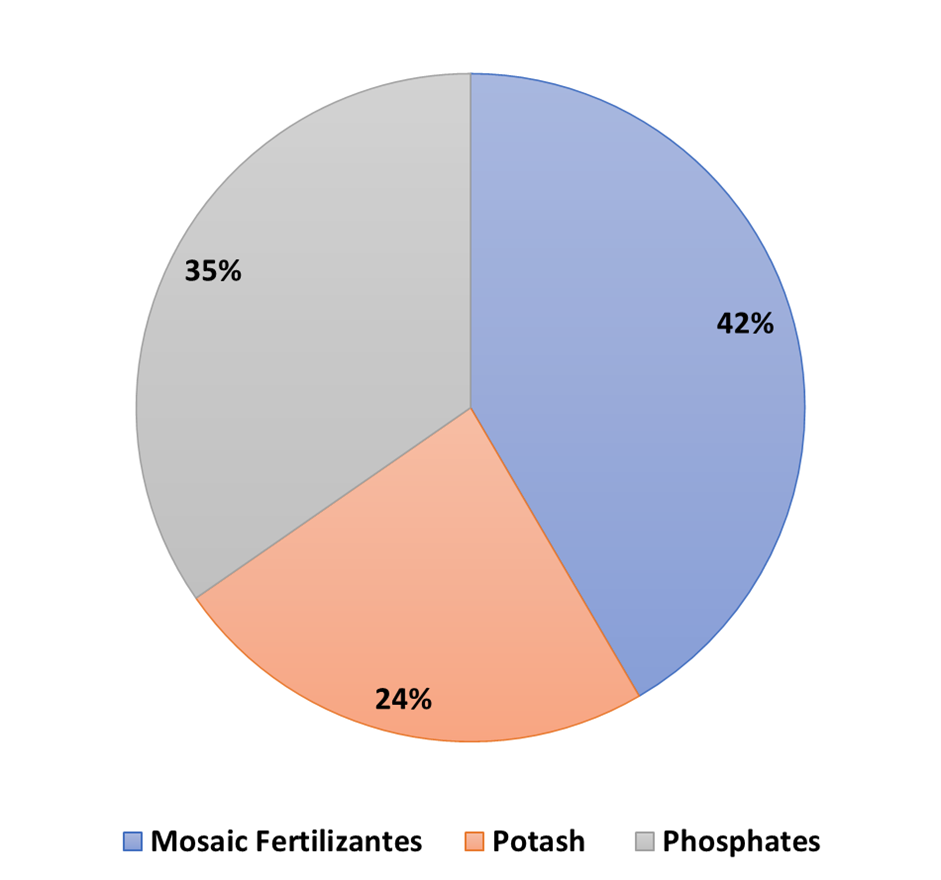
Mosaic's revenue structure by segment
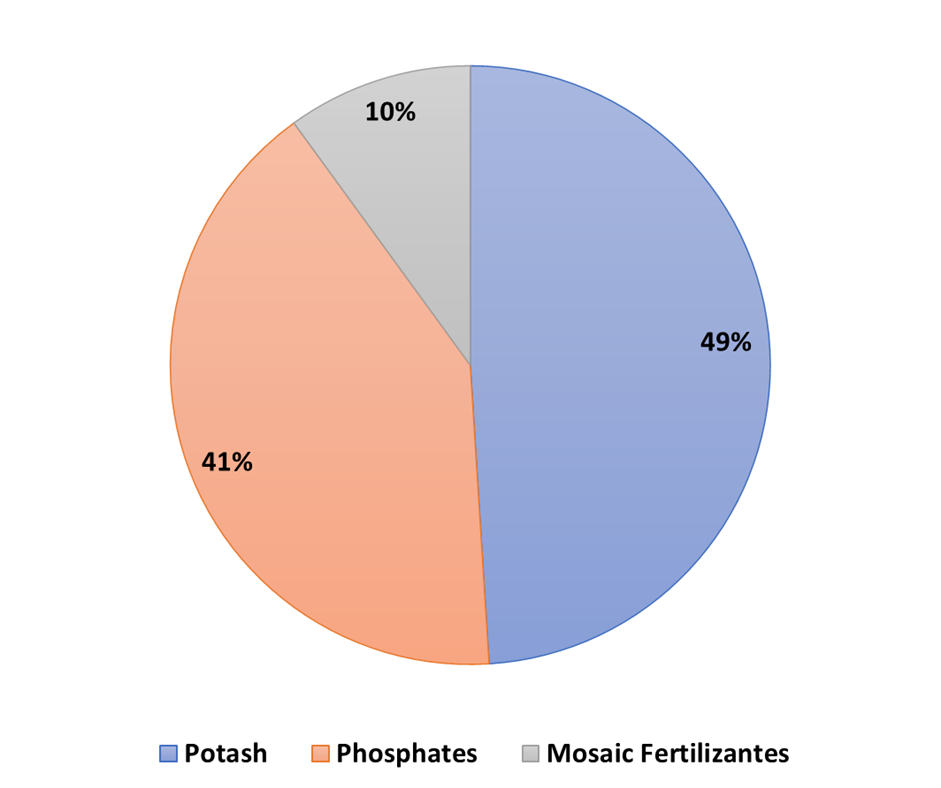
Structure adj. Mosaic EBITDA by segments
Agricultural and fertilizer market conditions are now normalizing. After a prolonged decline in 2022–2023, prices for phosphate and potash fertilizers have stabilized. Movereover, phosphate fertilizer prices showed a positive trend in H2 2023, which continued into 2024 for the DAP FOB NOLA price benchmark.
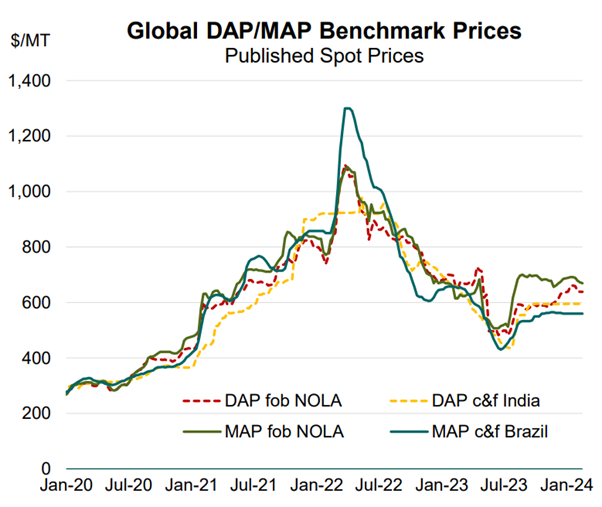
Phosphate fertilizer price dynamics
Mosaic's phosphate fertilizer business currently looks very promising due to improving global market conditions amid limited supply.
Thus, the company notes that phosphate fertilizer inventory levels remain low in North America. Against this background, the company's supplies through the end of Q1 were almost fully booked as early as the end of February 2024.
In Brazil, the situation is similar, with stock levels significantly lower than in the last five years. At the same time, demand for phosphate in the region is growing faster than globally. As a result, the Brazilian market is facing increased demand for phosphate fertilizers, as farmers need to simultaneously apply phosphate to the soil and build up phosphate stocks ahead of the next agricultural season.
Mosaic forecasts that fertilizer supplies to Brazil could reach an all-time high of more than 46 million tons in 2024.
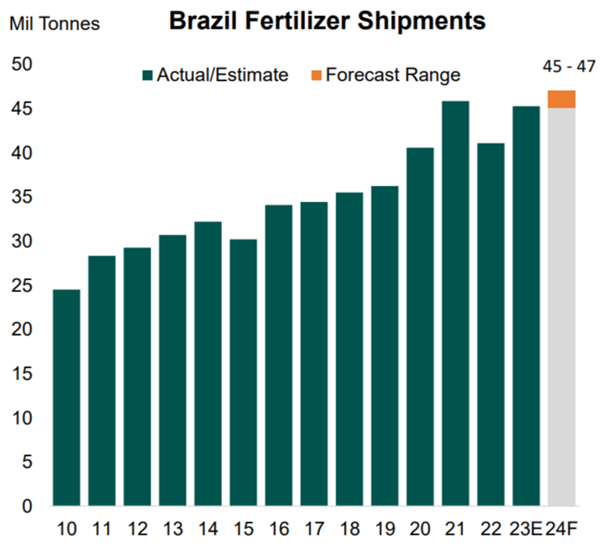
Forecast of fertilizer supplies to Brazil
The black swan for the global phosphate market in 2024 could be China, the global leader in the production, reserves, and exports of these fertilizers.
China has recently been paying particular attention to its internal food and industrial security, with the government curbing phosphate exports to international markets while prioritizing domestic demand.
In addition, the lithium-ferro-phosphate (LFP) battery industry is growing rapidly in China. Such batteries have a number of important advantages, such as longer life, no maintenance, greater safety, less weight, improved efficiency, etc., so interest in them is growing rapidly. Thus, over the past two years, LFP battery production in China has more than tripled to 1.7 million tons of finished fertilizer equivalent in 2023.
In other words, global phosphate supply may be limited in the coming years amid a decline in exports from China, the largest phosphate producer. The country is deliberately restricting exports and also increasing production of LFP batteries, which increases domestic demand for phosphorus.
Mosaic’s management expects strong market conditions in 2024 not only in the phosphate segment, but also in other business segments. The expectation is supported by the long-term outlook for fertilizer demand growth, as well as the recent low level of grain and oilseed stocks. Thus, stocks in 2023 amounted to around 16% of global consumption, one of the lowest levels since the turn of the century. By comparison, the figure exceeded 17.8% in 2014–2018.
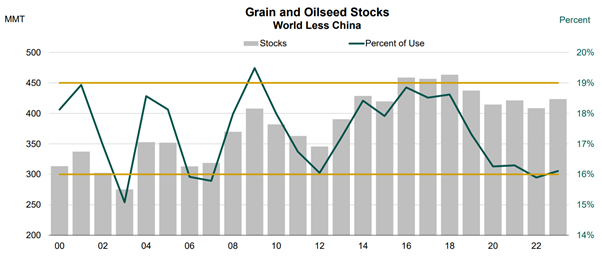
Grain and oilseed stocks to consumption ratio
As the graph above shows, there was a trend of gradual increase in the stocks of cereals and oilseeds (gray bars) between 2000 and 2018. However, over the past five years, the indicator has never exceeded the 2019 level. In this regard, Mosaic's management noted that the world's stocks of agricultural products was likely to increase in the coming months, which would inevitably lead to higher demand for fertilizers.
Mosaic expects another significant increase in both phosphate and potash market supplies in 2024. Moreover, both markets could record an all-time high, according to the company.
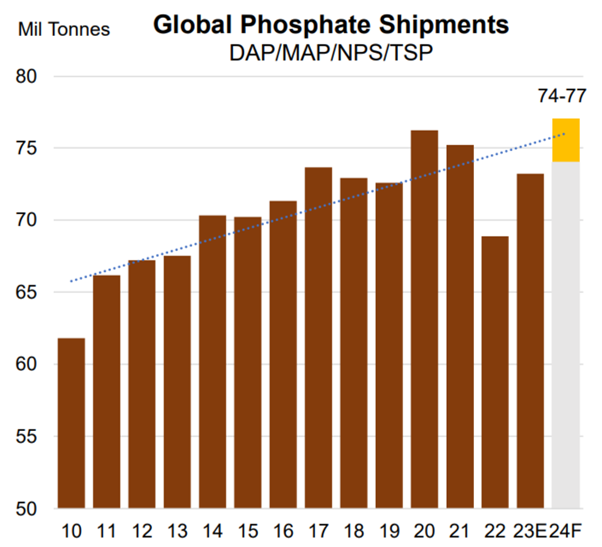
Phosphate fertilizer shipments
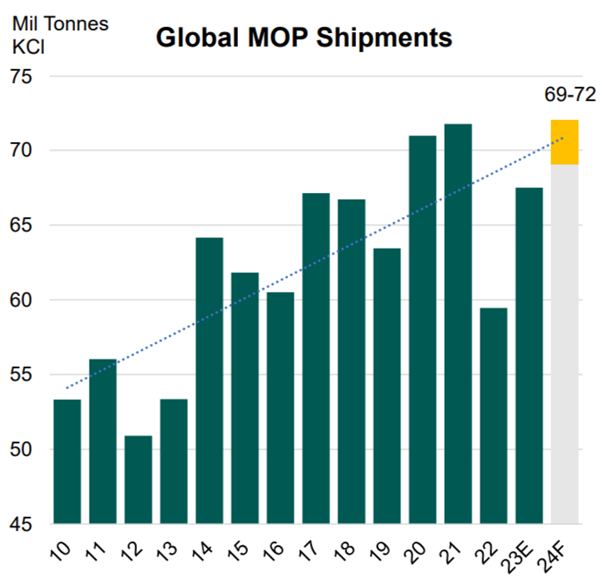
Potash fertilizer shipments
Thus, amid low global crop stocks, Mosaic expects increased demand for fertilizers in the company's key markets in 2024. At the same time, the continued restrictions on phosphate exports from China, which may lead to a global shortage of the product, may have an additional positive impact on the price environment.
Reason 2. Strategic initiatives
Although Mosaic is a mature business, it continues to grow by investing in priority projects and making better use of available resources.
Mosaic is currently betting on the phosphate market in line with market trends. Against the backdrop of supply uncertainty and price normalization, the company plans to significantly increase phosphate production to 8 million tons per year. The management announced this during a conference call with investors on the 2023 results.
By comparison, in 2023, Mosaic produced 6.6 million tons of phosphate and sold 7.0 million tons, which represents a slight decrease in production and increase in sales compared to 2022 results.
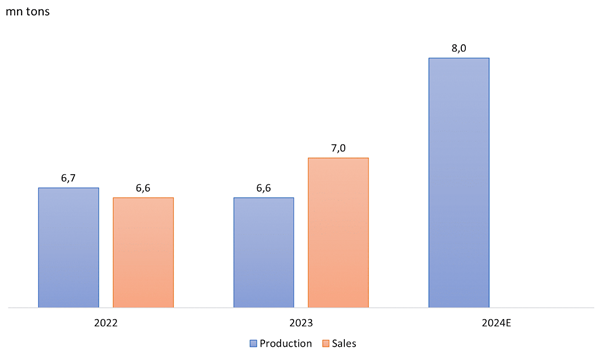
Actual phosphate production and sales, production forecast for 2024
According to Mosaic’s management, the goal of increasing production to 8 million tons per year will be achieved over the next few quarters. According to the company's forecasts, this will not only significantly increase revenue, but will also contribute to cost reductions due to economies of scale. This in turn is expected to lead to improved segment profitability in 2024.
Looking at the expected production increase based on the 2023 prices and margins, this means that dj. EBITDA could grow from $1.23 billion to $1.41 billion, or 14.6% year-on-year (YoY) in 2024.
Moreover, the company expects phosphate prices to increase in 2024. Thus, the lower boundary of the Q1 2024 forecast is $580 per ton versus $552 in Q4 2023. Thus, price dynamics should further accelerate the growth of the company's financial results.
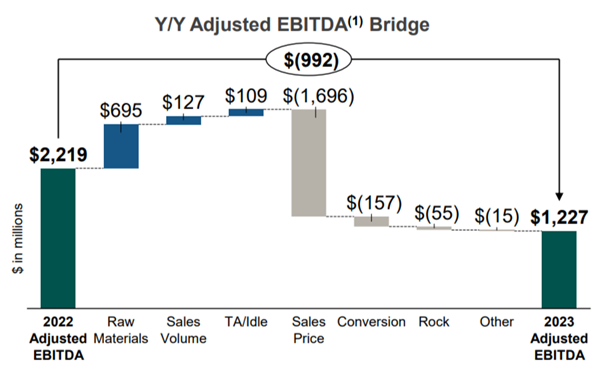
Dynamics adj. Mosaic EBITDA
Another of Mosaic's objectives for the coming year is to strengthen its presence in the Brazilian fertilizer market. As mentioned above, fertilizer supplies in the country are growing faster than in the world as a whole. In this regard, Mosaic decided to build a distribution center in Palmeiras with a capacity of 1 million tons to serve the fast-growing needs of the northern region of the country.
Mosaic also plans to increase production of value-added products within the Mosaic Fertilizantes segment. For this purpose, the company is currently expanding its production facilities in Florida.
In parallel, Mosaic is about to launch the next generation of its MicroEssentials Pro product, which has patent protection until 2038. This is an ammonium-phosphate product that helps to increase the efficiency of nutrient and micronutrient absorption.
Another Mosaic’s goal for 2024 is entering the market for the production of raw materials LFP batteries. The company announced the plan during the Q3 2023 investor conference call, without providing details, so the positive impact of the news on the stock price was limited.
Mosaic's board of directors has already approved a work plan for the construction of a plant to produce feedstock for LFP batteries. Given the US policy of creating an independent battery market, Mosaic's plans may attract significant investor attention in the coming months.
Thus, the implementation of Mosaic's initiatives aimed at business development in the current year may result in positive news that could drive a significant stock price revaluation.
Reason 3. Return of capital
During the 2023 year-end conference call with investors, Mosaic’s management reiterated the company's intention to continue distributing capital to investors through share buybacks and dividend payments.
Since 2018, the company has aggressively increased dividends, with the current dividend of $0.21 per share per quarter, representing an annualized yield of 2.7%. The latest dividend increase from $0.20 to $0.21 per share took place in December 2023.
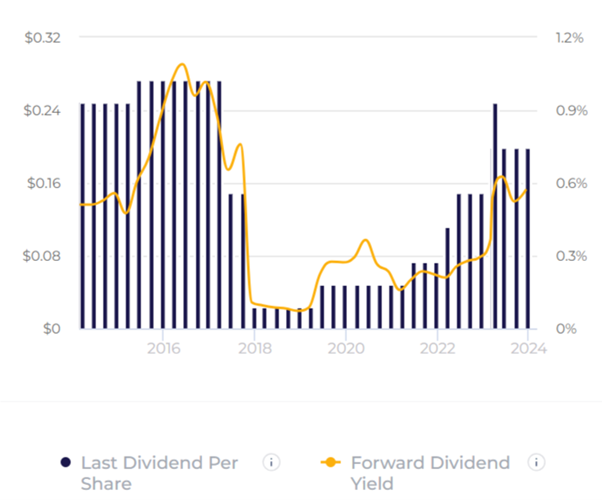
Mosaic dividends
In addition, Mosaic is repurchasing its own shares from the market under a program totaling $3 billion adopted by the board of directors in 2022.
Mosaic actively repurchased shares in 2022 and 2023, bringing the program’s authorized amount to $1.18 billion, or 11.78% of current market capitalization, as of the end of 2023.
High share repurchase volumes in 2022–2023 make it very likely that the company will maintain the buyback pace in 2024, which could be another driver of stock price growth.
Financial performance
Mosaic's financial results in 2023 can be summarized as follows:
- Revenue totaled $13.70 billion, down 28.39% from 2022.
- Aadj. EBITDA decreased from $6.22 billion to $2.76 billion. Adj. margin declined from 32.50% to 20.16%.
- Net income was $1.16 billion compared to $3.58 billion at the end of the previous year.
The decrease in revenue and profit was due to lower fertilizer prices. At the same time, the company noted growth in sales volumes over the past year.
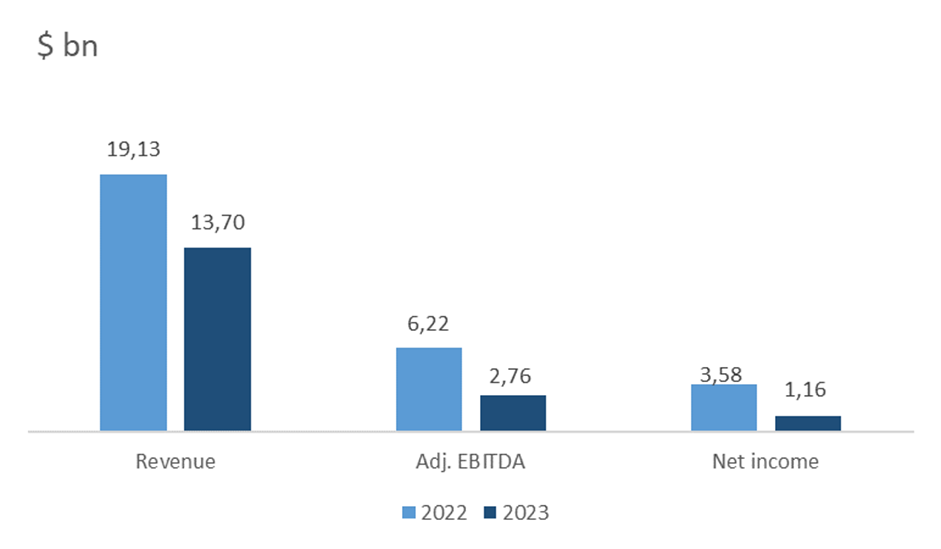
Dynamics of the company's financial indicators
- At the end of the most recent reporting period, operating cash flow fell to $2.41 billion versus $3.94 billion at the end of 2022.
- Free cash flow decreased from $2.59 billion to $0.80 billion.
The decrease in operating and free cash flows was mainly due to a lower net income.
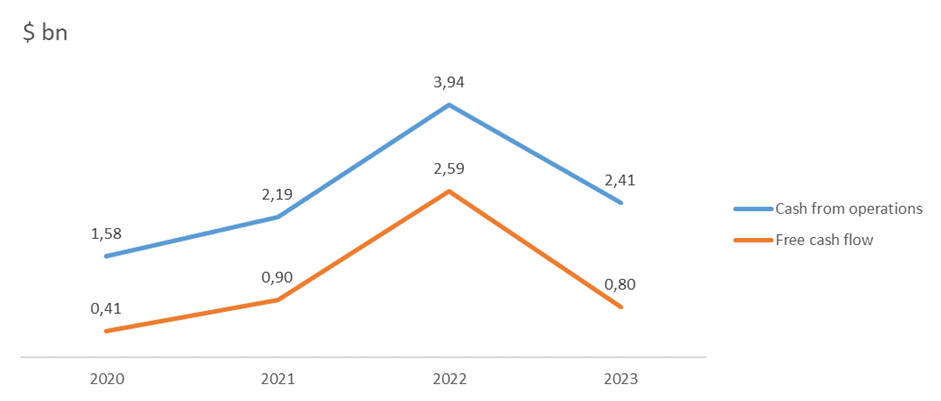
Company cash flow
Mosaic’s balance sheet can be characterized as healthy:
- Total debt is $3.76 billion.
- Cash equivalents accounted for $349 million.
- Net debt to adj. LTM EBITDA is 1.2x.
- The interest expense coverage ratio is at 10.3x.
Despite the low cash reserves, operating income significantly covers Mosaic's loan portfolio, indicating the company's good financial strength.
Stock valuation
Mosaic trades at a discount based on EV/Sales of 1.00x and EV/EBITDA of 4.95x, P/E of 9.04x, Fwd P/E of 10.52x P/FCF of 10.00x.

Comparable estimate
The average price target from top 15 Wall Street investment banks is $41.7 per share. According to our consensus, the company is undervalued by industry average multiples; the stock’s fair market value is $45, which implies a potential upside of 43.8%.
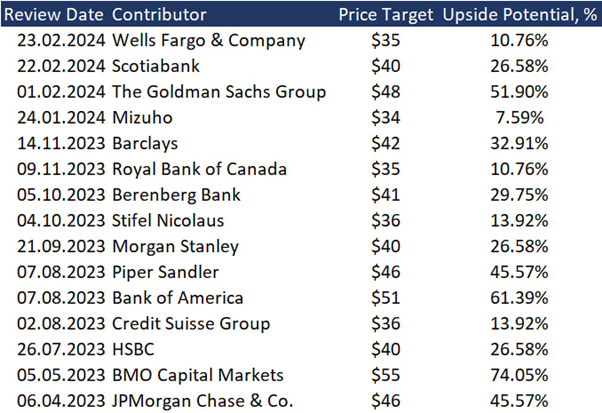
Price targets of investment banks
Key risks
Amid low potash prices, Mosaic announced the suspension of potash production at one of its facilities, Colonsay. The decision was in line with the company's strategy, according to which the plant should operate only under positive market conditions. Mosaic also noted that in the event of a rise in potash prices, Colonsay would be ready to return to operations immediately. In 2023, the plant produced 0.6 million tons of potash fertilizers, or 7.23% of the company’s total production. The plant’s production suspension is not expected to have a material impact on the company's results due to the commissioning and ramp-up of production at other capacities.
If Mosaic's forecasts for the 2024 global fertilizer supplies and demand do not materialize, it could reduce investor interest in the stock and could also lead to a deterioration in the company's financial results.
Increase in fertilizer exports from Russia and Belarus. If fertilizer exports from Russia and Belarus recover, the global nutrient market may become oversupplied, which would have a negative impact on price dynamics.
If Mosaic's new production facilities are not utilized, the company will incur additional maintenance costs, which could negatively impact its business margins.